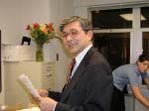CFC-Ozone Puzzle: Preface
| Topics: |
Series: The John H. Chafee Memorial Lecture on Science and the Environment
1st National Conference on Science, Policy and the Environment
Speaker: Karim Ahmed
Date: December 7, 2000
Location: National Academy of Sciences, Washington, DC
While it is relatively easy to speak about global degradation and the loss of natural resources, such as tropical forests, fisheries and coastal areas in many regions of the world today, it is instructive for us to examine an environmental success story, which is the subject of the inaugural John H. Chafee Memorial Lecture on Science and the Environment. It will show quite dramatically how, by using sound scientific and technical knowledge combined with a commitment to reach consensus in enacting an international treaty, we can achieve sound public policy to ensure a more environmentally sustainable future.
The subject I am speaking about is the destruction of our protective stratospheric ozone layer by man-made chemicals, known collectively as chlorofluorocarbons or CFCs, which were once considered to be miracle substances. While CFCs were known to have remarkable physical and chemical properties that allowed their extensive use in a variety of consumer products, they also possessed low human toxicity. Thus, they were employed as relatively safe refrigerant fluids in air conditioners and refrigerators and were widely used as propellants in aerosol cans. For instance, in the 1960s and 1970s, over two-thirds of all CFCs manufactured in the world were incorporated in aerosol cans for consumer products, such as underarm deodorants and shaving creams.

In the early 1970s, two physical chemists–Dr. Sherwood Rowland and Dr. Mario Molina, working together at the University of California, Irvine–discovered that the chemically inert CFCs could potentially break down in the stratosphere, which contains earth’s protective ozone layer. Under the influence of intense ultraviolet radiation in the stratosphere, they postulated in a path-breaking article in the journal Nature that CFCs underwent a series of chemical reactions to form highly reactive chlorine atoms, which destroyed a significant fraction of the protective ozone layer.
While the non-essential uses of CFCs, such as aerosol propellants, were being completely phased out in the United States by the late 1970s, the production of these commercial substances had, by the early 1980s, risen dramatically for use in new air conditioners and refrigerators, both domestically and overseas. It seemed that the worldwide market for CFCs had in fact increased, notwithstanding the initial attempts to reduce the commercial uses of these compounds.
Then a dramatic and far-reaching event took place. A group of scientists, who had been carrying out scientific measurements in Antarctica, noticed that a huge ozone hole developed each spring over the southern polar region, which lasted for many weeks at a time. At this point, even the most skeptical critic of the stratospheric ozone depletion theory, which included scientists in the chemical industry, began to concede that an unprecedented event of major proportion was happening to the global environment.
What is especially heartening about this environmental success story is that within a few years after the discovery of the Antarctic ozone hole, most national governments of the world signed and ratified the Montreal Protocol, calling for an orderly and step-by-step phase out of all CFCs and other similar halogenated compounds.
What did we learn from this turn of events? After the publication of the Rowland-Molina paper, the worldwide scientific community participated in a joint effort to elucidate and verify the original stratospheric ozone depletion theory. This led to the adoption of an international treaty that brought an end to the global use of a potentially harmful class of compounds in a systematic, well thought out and timely manner.
In recognition of their scientific contributions, Dr. Sherwood Rowland and Dr. Mario Molina–the two speakers at the inaugural John H. Chafee Memorial Lecture on Science and the Environment—along with their Dutch scientific colleague, Dr. Paul Crutzen, shared the Nobel Prize for Chemistry in 1995. Their contributions to both science and public policy is indeed an environmental success story that must not be forgotten as we continue to seek answers to other serious global environmental questions that we face today.
|
|
